Roll up, folks! You’re about to embark on a thrilling, riveting, and all-round gripping journey into the wild world of tire ratings. Okay, maybe it’s not as exciting as a high-octane car chase in a Hollywood blockbuster, but it’s certainly more practical. Not to mention, it’s safer – and let’s face it, probably less likely to end with us getting a stern talking-to from local law enforcement.
Jokes aside, understanding tire ratings such as 110v, 110h, 110w, 110t, 110y, 110s, and 110q is essential if you want to select the right tires for your vehicle. It’s not just a numbers and letters game; it’s about safety, performance, and ensuring your sweet ride stays on the road in all conditions.
What do 110t, 110s, 110q, 110h, 110r, 110v, 110w mean on a tire?
If these numbers and letters look like a secret code to you, don’t fret – you’re not alone. They’re actually part of a standardized tire code used worldwide to describe tire specifications. They detail information about the tire’s load index and speed rating.
The “110” you see is the tire’s load index. This is a numerical code corresponding to the maximum load that a tire can carry at the speed indicated by its speed symbol under specific service conditions. A load index of 110 means the tire can carry a load of up to 1060 kilograms or 2337 pounds. Yes, you heard it right! Those tiny, seemingly random numbers carry quite the weight – pun fully intended!
As for the letter that follows, this is the tire’s speed rating. It indicates the maximum speed at which the tire can carry a load corresponding to its load index under specific service conditions. But remember, this isn’t an invitation to crank the speedometer up to the max – it’s a safety limit to ensure optimal tire performance.
Let’s break it down into a handy-dandy table to visualize the information:
| Load Index | Maximum Load (kg) | Maximum Load (lbs) |
|---|---|---|
| 110 | 1060 | 2337 |
| Speed Rating | Maximum Speed (km/h) | Maximum Speed (mph) |
|---|---|---|
| H | 210 | 130 |
| V | 240 | 149 |
| W | 270 | 168 |
| T | 190 | 118 |
| Y | 300 | 186 |
| S | 180 | 112 |
| Q | 160 | 99 |
Now, let’s dive into the specifics, starting with our star of the show – 110T.
What does 110T mean on a tire?
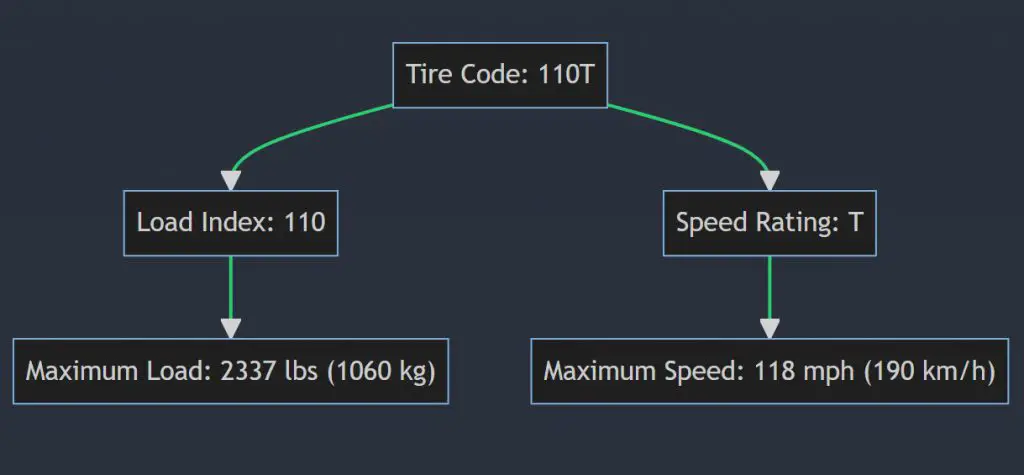
The combination of “110T” on a tire tells you two things:
- Load Index (110): The “110” signifies that this tire has a load index of 110, meaning it can support up to 1060 kilograms or 2337 pounds. This refers to the maximum load the tire can carry when it’s fully inflated. Load index is crucial because it allows you to match your vehicle’s load-carrying capacity with the tires’ ability to support that load.
- Speed Rating (T): The “T” here refers to the tire’s speed rating. A T-rated tire is approved for speeds up to 190 kilometers per hour (118 miles per hour). Remember, this doesn’t mean you should be driving at these speeds! It merely signifies the tire’s ability to dissipate heat at higher speeds. Overheating can cause tire degradation, and nobody wants a tire blowout at 100mph!
Why 110T?
You may wonder, “Why would I choose a 110T tire?” A 110T tire is an excellent choice for family sedans, vans, and small crossover vehicles due to its balance of good load capacity and moderate speed rating.
Moreover, T-rated tires are often associated with good all-season performance, handling, and ride comfort. They’re not built for speed demons or racetrack junkies, but they offer solid, reliable performance for everyday driving.
Points to Consider with 110T Tires
- Load Capacity: Always check your vehicle’s recommended load index before choosing a tire. Overloading your tires can lead to poor handling, increased tire wear, and even tire failure.
- Speed Rating: Stick to the speed rating recommended by your vehicle manufacturer. Using tires with a lower speed rating could negatively impact your vehicle’s handling performance and safety.
- Tire Maintenance: No matter the rating, proper tire maintenance is crucial. Regularly check your tire pressure, and don’t forget to rotate your tires as recommended to ensure even wear.
What does 110S mean on a tire?
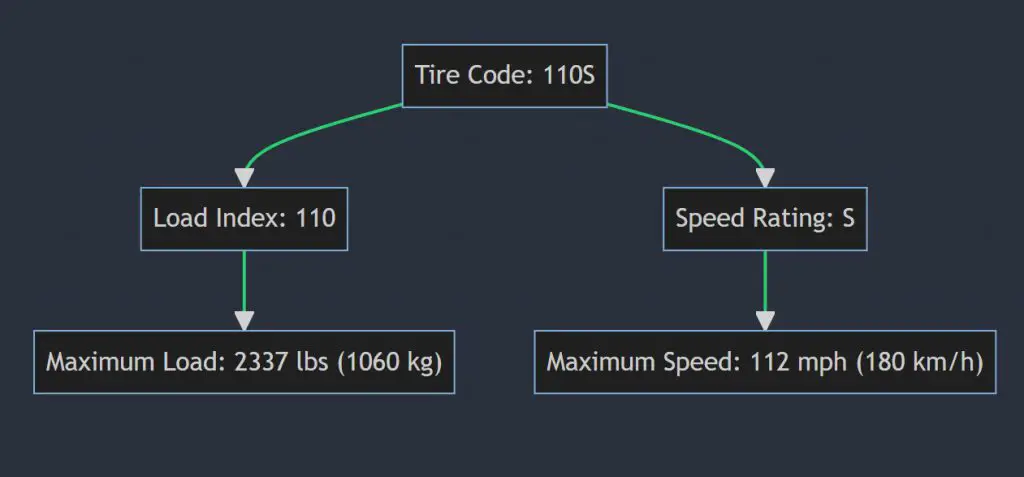
Welcome back to tire-ratings-101, where we dive into the nitty-gritty of tire ratings. We promise, it’s as interesting as watching paint dry – if the paint was essential for your car’s performance and safety! (Okay, maybe it’s not THAT exciting, but it’s important, alright?)
Let’s switch gears and turn our focus to a popular tire rating – the 110S.
Decoding the 110S
As we learned, the “110” is the tire’s load index, indicating that the tire can support up to 1060 kilograms (or 2337 pounds if you’re stateside).
Now, onto the “S”. The “S” stands for the tire’s speed rating, meaning it’s suitable for speeds up to 180 km/h or 112 mph. If you’ve got a need for speed, the S-rating might not satisfy your inner Lewis Hamilton, but remember, these aren’t race tracks we’re talking about – they’re everyday roads.
The Allure of 110S Tires
110S tires are known for their stability, making them popular for minivans, older sedans, and some SUVs. It’s a sensible choice for those who value safety and comfort over high-speed performance. After all, who needs the stress of racing around when you can enjoy a more laid-back, leisurely drive, right?
Key Takeaways for 110S Tires
- Load and Speed: Make sure you understand the tire’s load index and speed rating. These two factors are crucial for safe and effective tire performance.
- Vehicle Compatibility: Always ensure the tire rating matches your vehicle’s specifications. The last thing you want is a mismatch that might compromise safety and vehicle performance.
- Maintenance: Even with the right tire, maintenance is vital. Regular pressure checks, rotation, and alignment can enhance the tire’s lifespan.
What does 110Q mean on a tire?
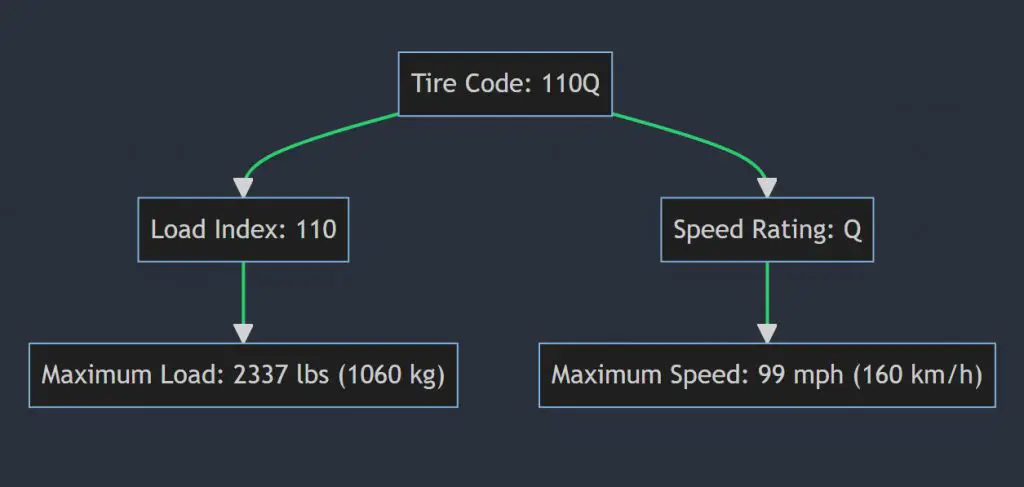
If you thought we’re done with tire ratings, think again! We’re just gaining traction here! (See what I did there?) Next on our roster is the 110Q tire rating.
Unraveling the 110Q
Once again, the “110” signifies the tire’s load index, allowing it to bear up to 1060 kilograms or 2337 pounds. The “Q” speed rating is a bit unique, as it is specifically meant for winter tires. These tires are rated for speeds up to 160 km/h or 99 mph, just right for those chilly winter drives.
Why Choose 110Q Tires?
110Q tires are often found on vehicles that need to brave winter conditions regularly. They balance excellent load-carrying capabilities with solid performance in cold weather. They’re not the “coolest” tire (pun intended), but they’re a reliable choice for those harsh winter months.
Pointers for 110Q Tires
- Seasonal Use: These tires are designed for winter conditions. Using them in warmer climates might cause rapid wear and tear.
- Vehicle Specs: Always match your tires to your vehicle’s recommendations. Mismatching can lead to poor handling and potential safety risks.
- Maintenance: Tire care isn’t just a summer activity. Winter tires also require regular checks for pressure, alignment, and rotation.
What does 110H mean on a tire?
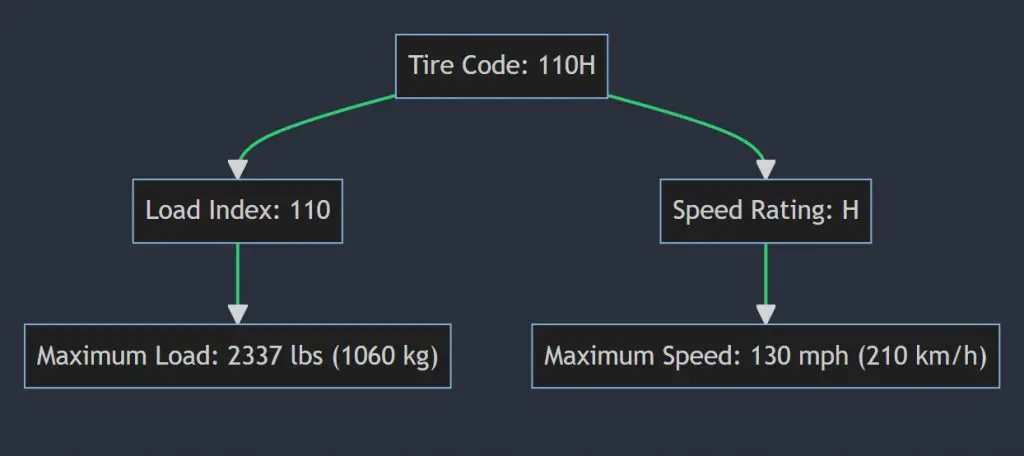
Moving along our tire-rating journey, we reach the ever-popular 110H. If you’ve ever thought, “What does that H stand for? Happy? Hilarious? High-flying?”, you’re in the right place.
Demystifying the 110H
We know by now that “110” signifies a load index of 1060 kg or 2337 lbs. The “H” speed rating denotes a maximum speed of 210 km/h or 130 mph. It’s not quite autobahn-level speeds, but it’s quite nippy for daily commuting and long road trips alike.
The 110H Appeal
110H tires are common on sedans, small SUVs, and some sporty cars. They provide a good balance between load-carrying capacity and speed potential, making them suitable for a range of driving conditions. They’re like the Swiss army knife of tires – versatile and reliable.
110H Tires: Key Considerations
- Load and Speed: Always understand your tire’s capabilities. A mismatch in load and speed ratings can negatively impact safety and vehicle performance.
- Vehicle Specs: Match your tires to your vehicle’s recommendations. You wouldn’t wear shoes that don’t fit, so don’t do it to your car!
- Maintenance: Tires are a key component of your vehicle’s safety and performance. Regular checks and maintenance can prolong the life of your tires.
What does 110R mean on a tire?
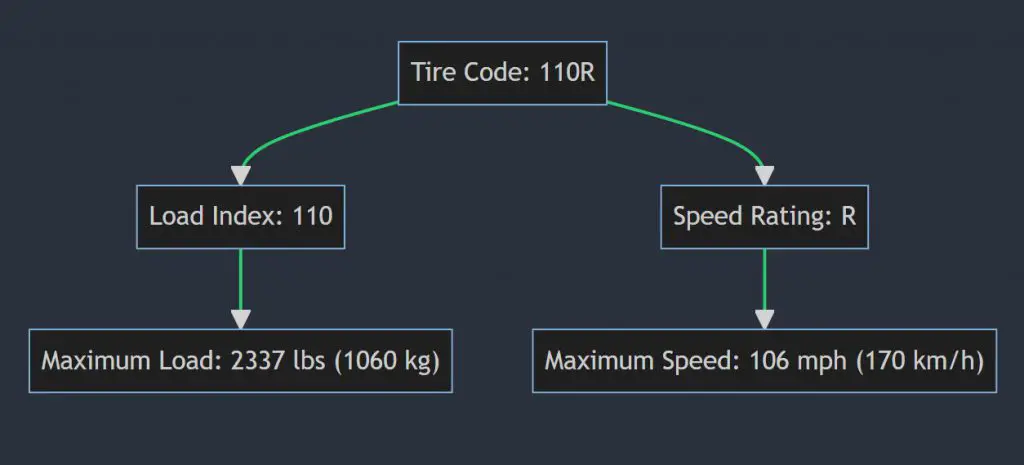
Welcome back to our tire-ratings adventure, fellow rubber enthusiasts! Next up on our decoding journey is the 110R tire rating. If you’re hoping the “R” stands for “Ridiculously Fast,” hold your horses – or should I say, tires?
Decrypting the 110R
The “110” part should be a familiar friend by now, signifying a load index of 1060 kilograms or 2337 pounds. However, when it comes to the “R” in tire ratings, we’re dealing with a different beast altogether.
You see, “R” doesn’t represent a speed rating. Instead, it indicates the tire’s construction type – in this case, radial. Radial tires are the most common type of tires today, praised for their durability, performance, and fuel efficiency.
Why Pick 110R Tires?
110R tires are like the all-rounder student in your class – they consistently perform well in various categories, whether it’s load-carrying capacity, durability, or fuel efficiency. They’re suitable for all types of vehicles, from compact cars to heavy-duty trucks.
Points to Consider for 110R Tires
- Tire Construction: Understand the differences between radial (R) and bias-ply tires to make an informed choice.
- Vehicle Compatibility: Always match your tires to your vehicle’s specs. Remember, your car and its tires need to work together like a well-oiled machine – quite literally.
- Maintenance: Regular tire checks and maintenance can extend the lifespan of your 110R tires.
What does 110V mean on a tire?
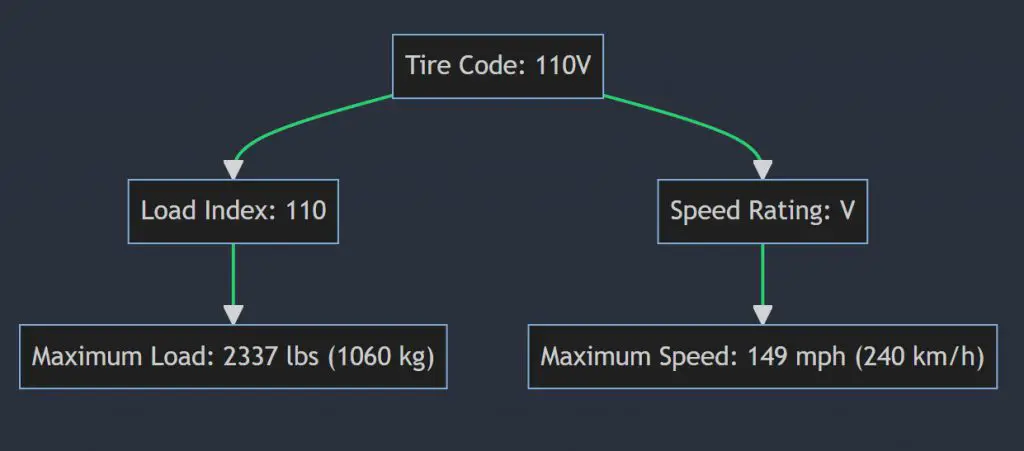
Fasten your seatbelts, folks, because we’re speeding onto the 110V tire rating! Let’s break down this high-speed rating that’s become quite popular among performance and luxury vehicles.
Breaking Down the 110V
As usual, “110” is our trusty load index, capable of supporting up to 1060 kg or 2337 lbs. The “V” represents the tire’s speed rating, signifying it can handle speeds up to 240 km/h or 149 mph.
The Appeal of 110V Tires
110V tires are like the sports stars of the tire world. They offer excellent performance at high speeds while still providing a significant load capacity. They’re most commonly found on sports cars, luxury sedans, and performance SUVs.
Things to Remember for 110V Tires
- Speed and Load: Understanding your tire’s speed and load ratings is crucial to ensure safety and optimum performance.
- Vehicle Specs: Ensure your tires align with your vehicle’s specifications. Mismatched tires can lead to a disappointing and potentially unsafe driving experience.
- Maintenance: High-speed tires need love too! Regular checks and maintenance can maximize their performance and longevity.
What does 110W mean on a tire?
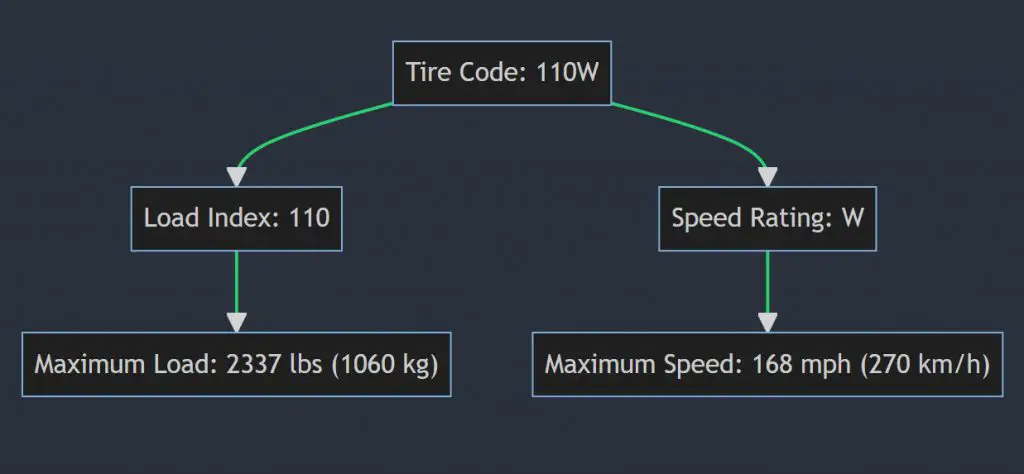
Last but not least on our tire-rating tour, we have the 110W rating. Prepare for some high-speed excitement as we delve into this popular choice among performance enthusiasts.
Unraveling the 110W
“110” is our load index, indicating a load-bearing capacity of 1060 kg or 2337 lbs. The “W” signifies a high speed rating, meaning these tires can comfortably handle speeds up to 270 km/h or 168 mph.
Why 110W Tires?
110W tires are often chosen for their top-notch performance at high speeds. They’re commonly found on high-performance vehicles, sports cars, and luxury SUVs. If you have a need for speed, these might just be your perfect rubber companions.
Key Points for 110W Tires
- Speed and Load: Comprehending your tire’s capabilities is key to safe and efficient driving.
- Vehicle Compatibility: Always ensure your tires match your vehicle’s recommendations. The wrong tires can hinder performance and pose safety risks.
- Maintenance: Even high-performing tires need regular care. Stay on top of your tire maintenance to keep them in top shape.
FAQs
You’ve made it to the FAQs section, where we address some burning questions that often arise when comparing different tire ratings. Let’s dive in and shed some light on these common inquiries.
110T vs. 110H: What’s the Difference?
When comparing 110T and 110H tires, the key distinctions lie in their speed ratings. Here’s a breakdown:
- 110T: The “T” speed rating allows for speeds up to 190 km/h or 118 mph.
- 110H: The “H” speed rating permits speeds up to 210 km/h or 130 mph.
In essence, the primary difference between these two ratings is the maximum speed capability. So, if you’re planning to hit the autobahn or enjoy some spirited driving, the 110H tires might be a better fit for you.
110T vs. 112T: Which One Should I Choose?
When comparing 110T and 112T tires, the primary factor to consider is the load index. Let’s break it down:
- 110T: Load index of 110, supporting up to 1060 kg or 2337 lbs.
- 112T: Load index of 112, allowing for a maximum load of 1120 kg or 2469 lbs.
In summary, the main difference between these two ratings is their load-carrying capacity. If your vehicle requires a higher load index, the 112T tires might be the better choice for you.
110T vs. 109H: Which Tire Rating Reigns Supreme?
When comparing 110T and 109H tires, we need to consider both the load index and speed rating. Here’s the breakdown:
- 110T: Load index of 110, supporting up to 1060 kg or 2337 lbs, with a speed rating of up to 190 km/h or 118 mph.
- 109H: Load index of 109, allowing for a maximum load of 1030 kg or 2271 lbs, with a speed rating of up to 210 km/h or 130 mph.
So, the main differences lie in the load-carrying capacity and speed rating. If you prioritize a higher load index, the 110T tires are the way to go. However, if a higher speed rating is more important to you, the 109H tires might be the better option.
110V vs. 120V: Is There a Speedy Winner?
Comparing 110V and 120V tires brings us to their speed ratings. Let’s explore:
- 110V: The “V” speed rating allows for speeds up to 240 km/h or 149 mph.
- 120V: The “V” speed rating permits speeds up to 240 km/h or 149 mph as well.
In this case, both ratings have the same speed capability. The difference lies elsewhere, such as the load index or other specifications. Therefore, it’s essential to consider factors beyond just the speed rating when making your tire selection.
110V vs. 110H: Which One Hits the Road?
When comparing 110V and 110H tires, the crucial factor is once again the speed rating. Let’s break it down:
- 110V: The “V” speed rating allows for speeds up to 240 km/h or 149 mph.
- 110H: The “H” speed rating permits speeds up to 210 km/h or 130 mph.
So, if speed is a priority and you’re looking for higher performance, the 110V tires have the advantage. However, if you’re more concerned about load-carrying capacity, the 110H tires might be the better choice.
Recap and Summary
To recap, tire ratings such as 110T, 110H, 112T, 109H, 110V, and 120V encompass a combination of load index and speed ratings. The load index determines the tire’s load-carrying capacity, while the speed rating indicates the maximum speed at which the tire can perform. It’s crucial to consider both factors when selecting the right tires for your vehicle.
Remember, always refer to your vehicle manufacturer’s recommendations to ensure compatibility with your vehicle’s specifications. Tire selection plays a significant role in safety, performance, and overall driving experience.
Now that you’re armed with the knowledge to decipher these tire ratings, go forth and make informed choices. Safe travels and happy adventures!
Alternative Tire Size Codes of Similar Specifications

AR Jeet has been a tire mechanic for over 2years. He has worked on all types of vehicles, from cars and trucks to RVs and ATVs and motorcycles. He has seen it all when it comes to tires, and he knows how to fix them.
AR Jeet is a tire expert, and he is passionate about his work. He loves to help people keep their vehicles running smoothly, and he is always happy to answer any questions that people have about their tires.
If you need help with your tires, or if you just want to learn more about them, then AR Jeet is the man to talk to. He will be happy to help you out, and he will make sure that you get the best possible solution.
He has a blog [Tirespick.com] where he writes about all things tire-related, and he is always happy to help people with their tire needs. Know more about AR Jeet.
